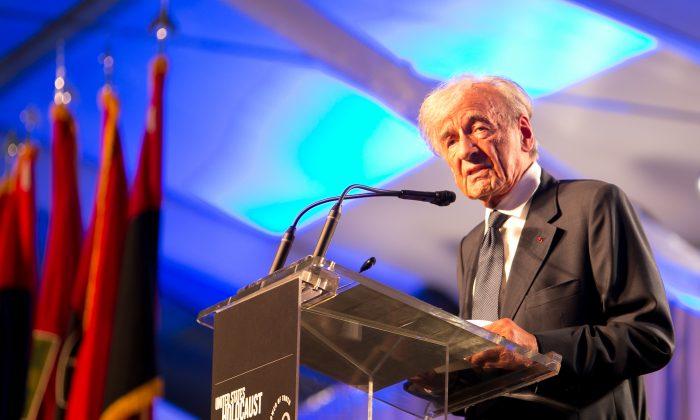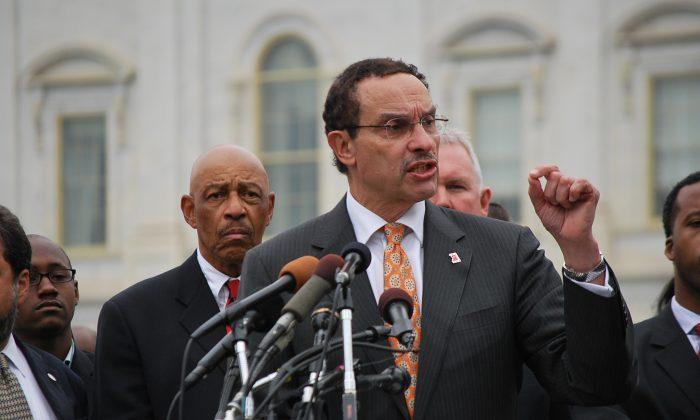WASHINGTON—The United States Holocaust Memorial Museum honored more than 840 survivors of the Holocaust and 110 World War II veterans at a national tribute Monday, commemorating 20 years since the museum’s opening.
In the spirit of uniting people around the remembrance of the Holocaust and the prevention of genocide in the world, the U.S. Holocaust Memorial Museum held a two-day event in Washington and announced a campaign and national tour titled, Never Again. What You Do Matters.
Thirty-six flags of the U.S. Army liberating divisions flanked the stage during the ceremony.
Former President Bill Clinton, and the museum founding chairman and Holocaust survivor Elie Wiesel spoke during the national tribute ceremony.
“Not all victims were Jews, but all the Jews were victims,“ said Elie Wiesel, who said it was important to honor all the victims of the Holocaust and not just the Jews. “We believe that in opening up the gates of our memory we are bringing people closer together,” he said.
The museum houses 16,280 artifacts and 12,500 survivor testimonies. It has had 35 million visitors during the past 20 years. Regarding the importance of these artifacts and records, Clinton said, it was important to ensure that “as direct memories fade away, that the record, pictures and stories never die.”
Wiesel addressed the youth who will carry on the memories after the survivors pass on. “It is your memory that inherited ours. Our memory lives in yours. Remember that young people,” he said.
The former president, who with Wiesel was present at the museum’s dedication when he was president in 1993, said that we needed the Holocaust museum as a place to remind us that “no matter how smart a people are, if you have a head without a heart, you are not human.”
Memories Live On
As part of the 20th anniversary campaign, the museum recommends 20 actions on its website that the public can take to honor the memory of the victims of the Holocaust and World War II survivors. The museum urges people to attend Holocaust remembrance public programs or traveling exhibitions in their communities, or to submit a story, or donate family artifacts to the museum, or share thoughts on the lessons learned from the Holocaust.
Undoubtedly, living survivors of the Holocaust and World War II veterans have had time to reflect on the horrors and atrocities they witnessed. And they are able to revisit the memories of the Holocaust through their own diaries, photos, and videos and those of other survivors.
“So I was hiding out in the heap of dead bodies because in the last week when the crematoria didn’t function at all, the bodies were just building up higher and higher. And I sneaked in, among those dead bodies because I was afraid they’d come back or something. So there I was at nighttime; in the daytime I was roaming around in the camp, and this is where I survived,” said Bart Stern, a Holocaust survivor born in 1926 in Hungary.
Stern was deported by cattle car to the Auschwitz extermination camp, where he was forced to drill and dig in a coal mine. As the Soviet forces advanced to Auschwitz in January 1945, the Germans forced most of the prisoners out of the camp on a death march that few would survive. He survived by hiding. He was 18 years old at the time.
Sterns words add to the historical record of the Holocaust and add a dimension to the images and videos housed at the museum of emaciated prisoners, heaps of dead bodies and charred remains captured by the liberators of the death camps.
Genocide Prevention
Survivors of the Holocaust have committed themselves to combat and end genocide around the world. The U.S. Holocaust Memorial Museum has likewise committed itself to this aim. The museum’s Center for the Prevention of Genocide raises awareness, and documents cases, of genocide around the world, identifies the signs and risks of genocide, and encourages people and governments to act to end genocide.
In Darfur in June 2003, a militia called the Janjaweed murdered and raped civilians, killing an estimated 300,000 people by 2005, according to the Committee of Conscience (COC), the museum’s genocide prevention program.
In September and October 2010, Michael Abramowitz, director of COC and Andrew Natsios, former special envoy to Sudan during the Bush administration, traveled to Southern Sudan to bear witness to the situation in Sudan ahead of the referendum expected to mark the culmination of a peace agreement to end the civil war between North and South Sudan.
“We were told that rebel group, the Lord Resistance Army, had attacked refugee camps. One evening they came. The Rebels decided to kill us. So they started selecting people to kill and my mom was one of them. They started beating her head with an ax. My mother died at that moment. … The boy came at me with a machete, he cut me on my face forearm and my breast. I pretended to be dead. I must have fainted, because when I woke up, everything was quiet, except I could hear children crying,” said Sunday Achan, who escaped from Sudan to Uganda.
Achan recounted her experience in a film by Lucien Perkins documenting the Committee of Conscience’s 2010 trip to Sudan.
Holocaust survivors and survivors of modern genocide such as in Sudan have different life experiences, yet they can relate to each other in ways that others may not. Holocaust survivors have shared many of their stories and they have documented their journeys of recovery. Yet for the people of Sudan, their wounds are just beginning to heal, and in some instances they are at risk of being reopened.
Gary Feuerberg contributed to this article



Friends Read Free